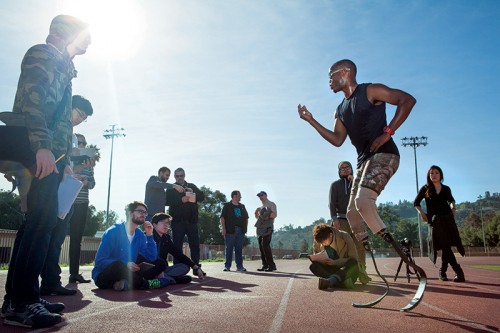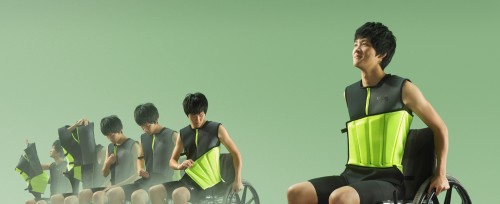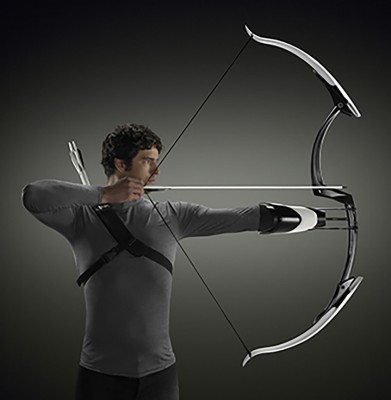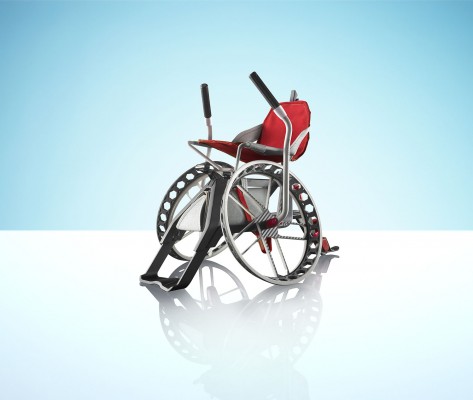- Kira Song’s floatation vest for brain-injured athletes with limited motion.
As the nation prepares to celebrate the 25th anniversary of the Americans with Disabilities Act (ADA) on July 26, the community of makers at Art Center College of Design continues to innovate products and experiences that help improve the world for people who have essential life function limitations.
Since its founding 85 years ago, students, faculty and alumni have been making a difference through inclusive design by applying a human-centered theory to assistive products and experiences for populations challenged by issues of aging, race, gender, ability, chronic disease, psychological or developmental disorders, and more.
“We have a community of students who want to leverage their creativity to impact people’s lives,” said Product Design Chair Karen Hofmann (BS 97 Product) who has guided designers making significant contributions through rethinking how products can improve people’s lives for more than a decade. “That’s the most meaningful work designers can do.”
Alumnus Seth Astle (BS 12 Product) is an ideal example of a student with a career-launching idea who was quickly hired by like-minded entrepreneurs at San Francisco-based 3D Systems Bespoke Innovations. Astle’s Cadence, a prosthetic and pedal system for para-cyclists, impressed the firm’s leadership. Bespoke created Fairings, 3D-printed and customized coverings that surround an existing prosthetic leg.
The John Tracy Clinic, a diagnostic and education center for young children with hearing loss is enthusiastic about a wearable real-time captioning prototype designed by a team of students inspired by a hearing impaired classmate using an inefficient device.

Brazil 2016 Olympic hopeful Blake Leeper demonstrates running blades for students and collaborators from global chemical company Eastman and Altair Engineering to improve existing inferior technology. Photo by Stella Kalinina (BFA 13).
Global chemical company Eastman and Altair Engineering collaborated with students to improve running blade technology. Double amputee Olympic hopeful Blake Leeper challenged the design community to re-imagine existing inferior equipment. Following a DesignStorm, Art Center’s trademarked immersive workshop to help corporate leaders guide product innovation, and with valuable input from student interns at Altair, Leeper and his team were introduced to a new blade system. Leeper’s goal is to qualify and compete in Brazil in 2016.
Then there’s Product designer Della Tosin (BS 15) developed Elle, an innovative prosthetic leg and swimwear for single-leg below the knee swimmers to assist the more than 1.8 million people living with limb loss today.
And there’s been no shortage of laurels draped upon Grad ID alum Neeti Kailas’ innovative hearing screening device for newborns in India. Together with her husband, Nitin Sisodia, Kailas launched Sohum Innovation Lab, where they continue to test, distribute and evolve the groundbreaking device.
Additional examples of inclusive design projects developed at Art Center include:
- The Elpis Para-triathlete flotation vest designed by Product Design student Kira Song for brain-injured athletes with limited motion
- MIT Accelerator grand prize-winning prosthetic socket designed to change shape through a patient’s lifetime by Jason Hill (BS 90 Transportation)
- A wheelchair equipped to traverse ice and snow by Product Design student Kuan-Yu Lin
- The Link bow for special needs athletes by Derrick Tan (BS 12 Product)
- Mobility solutions for people with physical challenges specifically paraplegics created by students in partnership with Honda
- A new approach to driving for aging and mobility impaired populations
- Future healthcare solutions for graying baby boomers











